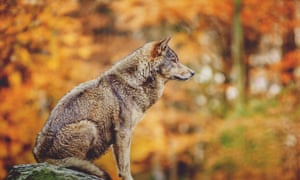
by Cal Flyn, THE GUARDIAN
There’s a monument near Brora, 60 miles short of John o’Groats, that claims to mark the spot where the last wolf in Sutherland was killed. I pass it often in the car. The wolf, it says, was killed by the hunter Polson in or about the year 1700.
I know this story. Polson, so it goes, was standing watch outside the wolf’s lair while his sons laid waste to the pups inside. When the she-wolf returned from the hunt, racing to the aid of her young, she bounded past the hunter and, as she did, he grabbed her by the tail. From inside the den – now plunged into darkness as Polson and the wolf struggled at its entrance – came, in Gaelic, a shout of alarm: “Father! What’s blocking the light?” To which Polson replied: “If the tail comes away at the root, you’ll soon find out!”
It’s an unlikely story, even as such stories go. The history of wolves is saturated with this kind of machismo and mythmaking. Here are all its stock ingredients: the lupine villain, the plucky hunter, the lucky break. Did it really happen? Probably not. Still, whether Polson is to blame or not, there are no wild wolves left in Scotland. By 1700, they had also long been extirpated from England and from Wales – though their old territory is commemorated in the form of names: Ulthwaite, Wolfenden, Wolfheles, Wolvenfield. Their deaths, too: Woolpit, Wolfpit, Woolfall. All across Europe there were centuries of open warfare against the wolf – that universal antihero, folkloric villain, sharp-toothed grandmother with a glint in her eye – which saw it hunted relentlessly wherever people lived, persecuted across continents and cultures.
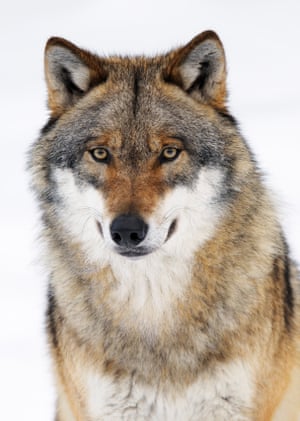
In Europe, those that survived retreated to rare enclaves, finding sanctuary on the high ground of the Apennines, or fleeing east into the debatable lands where Europe bleeds into Asia: Carpathia, the Balkans. There, the wolves in exile clung on, waiting for an opportunity, preparing for their victorious return.
If the trajectory of the European wolf is dispiriting, it is also familiar. We have become well acquainted with graphs that plot the advance of humans against the decline of all else. Everywhere we go, it seems, we wreak death and destruction, chipping away at the natural world. But over the last century, a different narrative has been writing itself into existence. In Europe, patterns of farming and land use have been changing on a grand scale, as marginal land – too steep or too depleted to be worth the effort of farming – falls into disuse. As the value of livestock has dropped, young people, too, have increasingly abandoned rural areas for cities. When they do, ever more land often goes unclaimed, unploughed, unrestrained. Some estimate that in the three decades leading to 2030, an area the size of Italy will have been abandoned within the EU alone.
While our attention has been elsewhere, nature has been expanding into the gaps left behind. As annual crops fade away without human input, shrubs and fast-spreading thorns take their place. Then tiny trees take root and the ground starts to bristle with new life as soft and hard woods, hoisted from the earth, spread a densely embroidered tapestry of life across the landscape. The still summer’s air is soon vibrating with the tiny wings of insects. Songbirds raise their voices, trail up and down the scales, an orchestra coming into tune. Rabbits, badgers and foxes dig their homes between the roots. Deer graze in shabby pastures, leap tumbledown gates. Along the rivers’ edges, otters dive and beavers build their dams – some reintroduced, many recolonising territory of their own accord. Mice nest in old barns. Wild boar rootle in new woods.
And, of course, wolves.
There are an estimated 12,000 wolves in Europe now, far more than in the contiguous US – where the grey wolf was similarly persecuted, until legal protections came into force in the 70s – and they have now been documented in every single country on the European mainland. In 2017, the first wolf for more than a century was spotted in Luxembourg and the first wolf was sighted in Denmark for 200 years. Last year, wolves were confirmed to have set up home in a Dutch national park. These are all crowded countries, intensively farmed and densely populated, and the wolves’ presence there indicates how closely our ranges have come to overlap. Recently, while the residents of Scanno, Italy, were confined inside to halt the spread of Covid-19, four wolves were seen to hunt a herd of deer through the town; they took down a hind and devoured it right there in the street.
Mainly, however, the wolves live where we have ceded ground. Iberian wolves now wander the ghost villages of Galicia, and Eurasian wolves haunt abandoned cold war-era military sites along the former iron curtain. In the early 00s, they crossed the border into Germany from the dense forests of Poland, finding sanctuary in former army testing ranges and post-industrial ruins. There are now more than 100 German wolf packs, each of five to 10 animals, occasionally more. Where we have withdrawn, they have grown. Our loss has been their gain.
But then again, maybe that’s the wrong way to think about it. Perhaps their gain could be our gain, too; perhaps their return heralds change for the better, for the whole ecosystem. In recent years, scientists have come to appreciate the full impact that an apex predator, such as the wolf, can have upon its wider environment. The seminal case study that guides thinking on this issue is that of Yellowstone national park, 3,500 square miles of protected land in north-west Wyoming. There, the 1995 reintroduction of grey wolves into the environment after a 70-year absence has offered insight into the influence of large predators upon the behaviour of grazing animals, their prey.
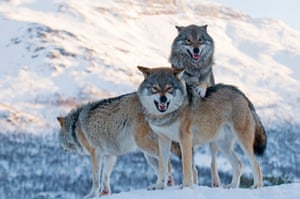
As far as the elk and mule deer of Yellowstone were concerned, the return of the wolves changed everything. Though they had faced some predation throughout – not least from humans with guns – they had grown used to milling freely through the open landscape, grazing hither and thither. Heretofore relatively peaceful sunlit glades and fragrant sagebrush meadows became gauntlets to run, through which they moved as targets. They grew nervy, hesitant. They kept on the move through the clearings, bunching tightly together in agile, watchful groups. They snatched mouthfuls on the move, and ate less overall.
Those that did survive behaved differently, too: when the wolves were on the prowl, they retreated to the dimly lit comfort of the woods, where they might wander in clandestine bands. They avoided the cougars, most active at night, by steering clear of landmarks where they might be trapped or surprised from above in the dark – ravines, outcrops, embankments. No longer did they live in an environment defined by its waterholes and pastures, or even by its ridgelines and ravines, but by areas now suffused with danger and relief. A psychological topology, this – one marked with hillocks of anxiety and peaks of alarm. Ecologists know this as “the landscape of fear”.
And as the deer’s psychological landscape metamorphosed in the presence of the wolves, so too did the physical landscape that underlay it. As deer numbers fell and grazing habits changed, the willow, cottonwood and aspen seedlings they had been stripping from the clearings were granted a reprieve. Undergrowth thickened. Leafy stands grew up along the river edges. In this way, fear is a force that shapes the world.
Here in Scotland, red deer have been running rampant for decades. Thanks to the lack of natural predators, and the sporting estates’ habit of feeding them through winter, numbers have more than doubled since 1959, rising from 155,000 to an estimated 400,000. Highland landowners have been pressed into service as ersatz wolves, and are now required by law to spend months stalking smooth-skinned hills – bitten down to the quick by hungry mouths – with loaded rifles; and they do so, some more enthusiastically than others. In this way, last year, 80,000 red deer were culled.
But wolves will not return on their own. We are separated from the wolf packs of continental Europe by the sea; if we want wolves in Scotland, haunting the hills, we will have to invite them in.
The hunting lodge at Alladale sits on a low rise, overlooking the glens that form the body of Paul Lister’s Highland estate, 30 miles inland from the monument at Brora. It’s a grand, stone-built Victorian country house with bay windows and high ceilings. When I arrive there on a hot summer’s day, I find a half-dozen stags dozing peacefully on the lawn, looking sleek and lithe, docile as cows, their antlers trimmed with a velvet of russet and gold.
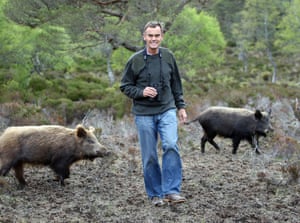
I step towards them, right up to them, almost – I’m maybe three metres away when they finally heave to their feet and swing to face me, almost defiantly, before trotting into the trees that mark the edge of the garden. “No fear,” comments Lister. That’s the problem.
Lister is a vigorous man, slim and tanned, in his 60s. The heir to a vast fortune made in furniture, he has been sinking a sizeable part of it into the rewilding of this Highland estate since he bought it in 2003. Back then, there were 25 deer per square km; today, through a combination of “population management” – that is, shooting them – and extensive deer fencing, his staff have brought that figure down to four or five. These days, he doesn’t call it an estate, but a “wilderness reserve”.
Whatever you want to call it, the results of the work are tangible, easily visible to the naked eye. We bump down a track in a Land Rover to view how this is a place shivering with summer foliage, so unlike the naked hollows of the glens I know so well – those cavernous spaces, those glacial curves. Birch and aspen tremble along the river’s edge, swollen with the very last of the snowmelt. Scots pine shin up the very steepest slopes, bilberries blooming in their shadow. None of this came about by accident. These trees were planted in batches, tens of thousands of them at a time. The oldest are now approaching two decades in the ground, and are maturing in safety, behind 6ft-high fences that march along the road’s edge and then up and over the ridgeline. Between their branches, unseen, scamper red squirrels: native to the area but boosted by releases from elsewhere. Back at the lodge, wildcat kittens romp in a pen, part of a reintroduction project that could see them set loose within a couple of years. All of it part of the same grand plan.
But what Lister really wants is this: a 50,000-acre enclosure within which wolves run free alongside the deer and the rabbits and the squirrels and the wildcats and all else. The hope is that the wolves would take it upon themselves to “manage” the deer population, starting with the weakest – the old, the sick, the starving – and working up, keeping them on their toes, on the move, relieving the grazing pressure on the hills and thus liberating the land to attain a level of fertility not seen for centuries.
Lister views this as a way to restore a crucial self-righting mechanism to an ecosystem thrown haywire, an ecosystem where “nothing makes sense” any more. Morally speaking, he says, “it’s the right thing to do”. Before, we killed the wolves and the bears and the lynx – trapped them, bludgeoned them, flayed them alive – “because they were inconvenient to us. What gave us the right to eliminate other species? It’s disgusting. So when we have the opportunity to put something back, albeit in a controlled way, it should fill us with joy.”
Still, his plan – heavily modelled on the game reserves of South Africa – retains a great deal of hands-on interference with the “natural way of things”. The wolves themselves would require population management. “If you put a pack of wolves in here, they’re soon going to make two packs, then you have to step in and neuter the females. It’s the only way to do it.” The game reserves do it all the time – “play God” – but perhaps it’s the best we could hope for in a broken world.
“Either that or nothing,” Lister tells me.
Lister’s wolf plan – limited though it is in scope – has met with stiff resistance from almost every corner. Trembling voices speak up at public meetings, frightened for their safety. Bureaucratic hurdles emerge that may prove insurmountable: animal welfare controls prevent the keeping of predators and prey enclosed together; hikers point to their right to roam Scottish lands, enshrined in law. People here, says Lister, have forgotten what it means to live alongside predators. They are obsessed with livestock, their helpless pets. They kick and squeal, refuse to adapt their ways for a wilder future. What could it cost us, this risk aversion? While we’ve been wringing our hands over a few dozen beavers, refusing even to countenance the reintroduction of lynx, Europe has been rewilding of its own accord. Wolves brook no bureaucracy. They do not believe in borders.
Our fear of wolves is out of all proportion to the danger they pose us. Wolves very rarely attack humans, and even actively avoid us. One might live a lifetime in the woods with a pack of wolves for neighbours and never see a single one. When thinking of reintroductions, we must be circumspect, realistic: the risk of wolf attack is small. Tiny, even. Still, it is not zero.
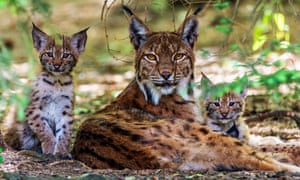
Mark Mennle knows well the risks that wolves can bring. Mark is in his mid-40s, a shepherd from Prignitz, in Brandenburg, in the east of Germany. An itinerant shepherd, he grazes his flock of 600 sheep on state-owned grassland and between the panels of solar farms in a region where wolves have firmly re-established themselves in the space of a decade.
He, like all farmers in the area, has had to adapt his practices to the wolves’ return. In some parts of Europe – mountainous regions, where the sheep roam free – shepherds have reverted to rearing more “primitive” breeds, better able to fend for themselves against a predator’s threat. In Brandenburg, a flat, rather sandy, plain crisscrossed with rivers and ribbed by dykes, Mennle uses specialist electric fencing, pinning it to the ground to stop wolves getting in underneath. He uses more traditional methods, too: he had to trade in his quick, compliant sheepdogs for a powerful, bear-like breed – the Illyrian shepherd dog – that lives in among the sheep as their protectors. But the dogs themselves can be difficult to handle. It’s a hard balance to strike: they must be safe to coexist with ramblers and cyclists, but aggressive enough to start a fight with a wolf. Like hiring Hells Angels as security: things can go sour fast. Last year, a man came by, walking a pet dog – a scrappy little thing that strained at the lead and barked. One of Mennle’s guard dogs grabbed it, pulling the lead from its owner’s grip, and killed it. The furious man came at Mennle with a stick.
He has 17 of these guard dogs now. They are expensive animals, each one worth far more than a sheep. “Last year, I had to explain to my seven-year-old daughter that I couldn’t get her a Christmas present because I had to buy a new dog. That was heartbreaking.” He doesn’t own his land. At this rate – the extra costs of security, the growing losses – he never will. For even with the dogs, his flock is not safe.
Massacres like this – killing beyond all possible hunger, as if for sport – are not unknown among wolves. When hunting deer, they will separate their victim from the herd and seize it; when it falls, its fellow deer will run, abandoning it to its doom. But sheep are different. They stay together. Even as the wolves are stripping their sisters for parts, they herd ever more tightly together, bleating, ready for slaughter. Blood-crazed wolves, adrenaline pumping, will kill, and kill, and kill. As Mark rushed to the scene, he had been struggling to align what the police had told him with what he knew of his animals. He had left the flock miles from here, grazing contentedly, only the night before. The wolves hunted them for 5km,” he says. “Can you imagine that?”
As wolf numbers rise across the continent – as packs grow, split and reform – here we sit on our island, watching through our fingers, patrolling our perimeters. There is no serious consideration of releasing wolves into the UK countryside – at least, not in the foreseeable future.
Efforts to reintroduce the comparatively small and harmless lynx, for example – seen by some as a stepping stone to the ultimate goal of bringing back wolves – remain extremely controversial, while beavers “unofficially” released into Scotland’s Tayside 15 years ago, where they continue to thrive, are a major source of contention.
At the Highland Wildlife Park near Kingussie – a 260-acre facility run by the Royal Zoological Society of Scotland – I stop in to observe the resident wolf pack at feeding time. Here, a family group of six animals lives in a high-sided compound: a square of pine trees, cordoned off and scattered with woodpiles and platforms. I watch them through plastic glass, racing for scraps thrown in over the side. Large animals – perhaps the size of a great dane – but limber, agile, flowing over obstacles like water, their legs pistoning. They are shaggily dressed in furs of tawny and buff, with bulky, leonine ruffs around their necks.
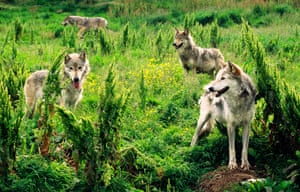
But these are not dogs. Look at their pelts, their strength, the size of their heads, their claws. Wild creatures. Or nearly. This pack, the keepers remind me, is an artificial construction. The male and female at its head have an uneasy relationship. They bicker, undermine the other’s authority. They would not have settled for one another, given the chance. Still, they breed. Wolves are good like that. Pragmatic.
The question is: now what? The female keeps her adolescent daughters in check. Soon, in the wild, these young females would leave the pack in search of mates; roam as lone wolves through strange lands. But there is nowhere here for them to go. They cannot be released – they likely never will be free. So these captive wolves have taken on an uneasy status: not wild, nor yet domesticates. Are they truly wolves at all?
• Additional reporting by Theresa Breuer. This is an extract from The Wolf at the Door by Cal Flyn, published in Granta 153: Second Nature.

No comments:
Post a Comment